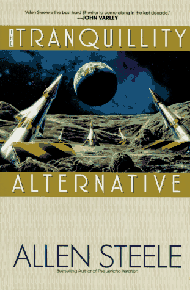

THE TRANQUILLITY ALTERNATIVEby Allen SteeleAce0-441-00299-4306pp/$21.95/March 1996 |
 Cover by Bob Eggleton |
Reviewed by Steven H Silver
I've always enjoyed reading Allen Steele's works and I enjoy reading alternate history, so I was looking forward to reading his newest novel, The Tranquillity Alternative, which describes a world in which the Nazis and Americans used suborbitals as early as 1944. Unfortunately, although the book succeeds as a good Allen Steele novel, it mostly fails as an alternate history, sometimes, so badly that it affects the Allen Steele aspects of the novel.
The Tranquillity Alternative is set in the same universe as Steele's two alternate history stories "Goddard's People" and "John Harper Wilson" (both can be found in his collection Rude Astronauts. However, while Steele was able to maintain his alternate history for the short space of those stories, he is unable to expand it to novel length. His background is that on the same day the Nazi's launched the suborbital flier "Amerika Bomber", the Americans countered with their own suborbital "The Lucky Linda" (described in "Goddard's People"). The space race, therefore, began in 1944. Despite this early start, many important dates, such as the first moon landing (see "John Harper Wilson") and the Challenger explosion, correspond to our own history.
One of Steele's strengths is the way he works popular culture into his writing. In the case of The Tranquillity Alternative, this results in the failure on the alternate history side. Too little has changed. Song titles and television shows are almost uneffected by the changes in history. People's careers take slightly different courses, but Bill Clinton still becomes president in 1992, Ronald Reagan still changed his political party and was president during the Challenger explosion. Morton Thiokal still won the contract which led to that explosion. Computers still seem to have had the same development, down to the terms and standards used.
The novel, which details the final American mission to their lunar earthbase before turning it over to the Germans (represented by two astronauts nicknamed "Hans" and "Franz" after the Saturday Night Live characters in another jarring aspect of non-alternative history). Steele peppers the story with his detailed knowledge of space-exploratory protocol for a strong feeling of versimilitude.
Whether or not NASA and other space agencies work the way Steele describes them (and he talks about NASA and the ESA even with history altered as it was), he describes them (in this book and others) in a style which should be true if it isn't. Although occasionally Steele's space-tech lingo slows down the story, at the same time it makes the events believable. Spider Robinson once commented that if an SF author were to accurately describe space travel it would be boring in the extreme. Steele doesn't go quite as far as Robinson's warning. Instead, his description makes you believe these events could actually happen.
If you haven't read Steele before, I would not recommend starting with The Tranquillity Alternative. Although the style is typical of Steele's writings, the logic behind the novel is not as strong as that which he brings to his future history works or The Jericho Iteration.
Purchase this book in paperback from  .
.
| Return to |